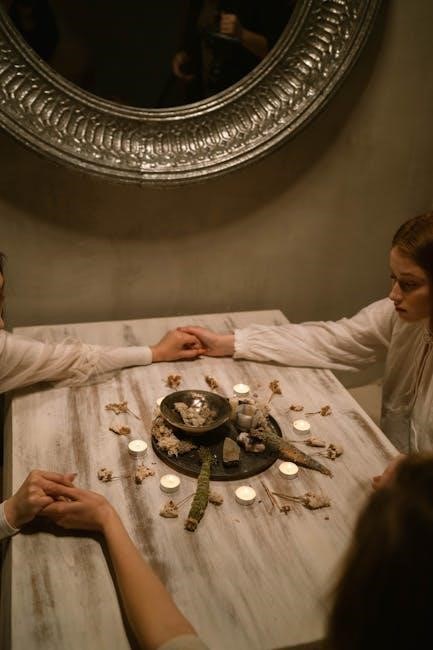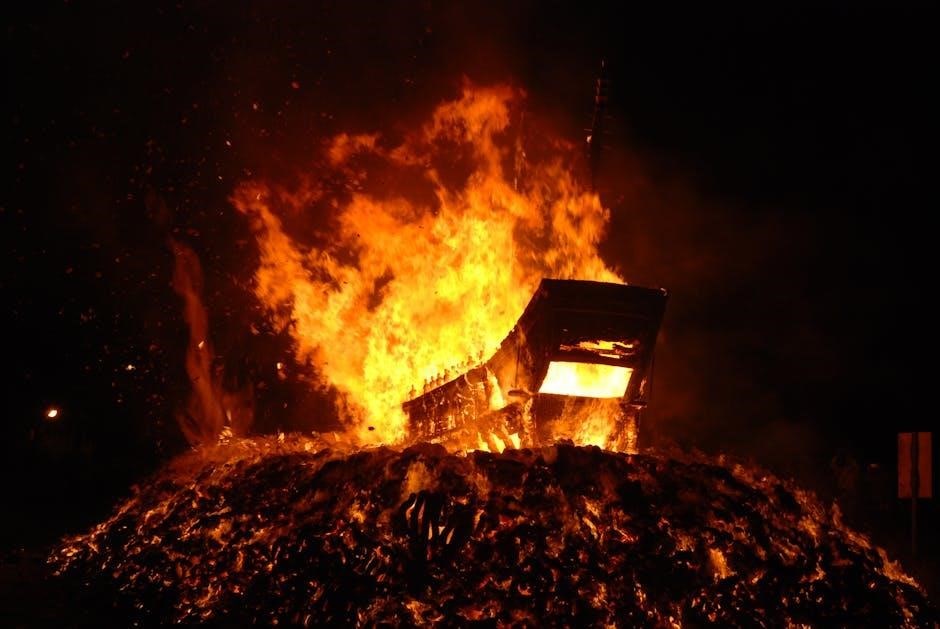A Witch’s Guide to Burning: Historical Context and Practices
This section delves into the dark history of witch hunts, exploring the investigations and persecutions that spanned Europe and the American colonies. It examines the practices surrounding accusations, trials, and executions of those labeled as witches.
Origins of Witch Hunts
The origins of witch hunts are complex, rooted in centuries of superstition and fear. Belief in magic and spirits predates Christianity, but the demonization of these practices intensified during the Middle Ages. The shift in Christian theology and the rise of inquisitions contributed significantly to the persecution of individuals accused of witchcraft. Economic anxieties, social unrest, and political instability further fueled these hunts. The publication of texts like the Malleus Maleficarum, or “Hammer of Witches,” codified beliefs about witchcraft and provided a framework for its prosecution. These factors combined to create a climate of fear, leading to widespread accusations and trials across Europe and beyond.
The Great Hunt (1560-1630)
The period between 1560 and 1630 witnessed an escalation in witch hunt activity, often referred to as the “Great Hunt.” During this time, tens of thousands were accused, tried, and executed for witchcraft across Europe. This surge in persecution was fueled by religious tensions, social anxieties, and political conflicts. The Protestant Reformation and the Catholic Counter-Reformation created an atmosphere of heightened fear and suspicion. Accusations often targeted marginalized individuals, particularly women, who were seen as vulnerable to demonic influence. The widespread use of torture to extract confessions further exacerbated the problem, leading to the deaths of countless innocent people; The Great Hunt stands as a dark chapter in European history.
Accusations and Confessions
Accusations of witchcraft often stemmed from a variety of sources, including personal disputes, social anxieties, and religious fervor. Individuals might be accused of causing illness, crop failure, or other misfortunes through magical means. Once accused, suspects faced intense pressure to confess, often through torture. Confessions, whether genuine or coerced, frequently implicated others, leading to a cascade of accusations and trials. These confessions often detailed fantastical acts of devil worship, sabbats, and malevolent magic. The use of spectral evidence, where accusers claimed to see the accused in visions performing witchcraft, further fueled the hysteria. The cycle of accusation and confession created a climate of fear and distrust, making it difficult for anyone to escape suspicion. The lack of due process and reliance on dubious evidence made the process inherently unjust.
Methods of Execution: Burning at the Stake
Burning at the stake was a common method of execution for those convicted of witchcraft, particularly in continental Europe. The practice was rooted in the belief that fire could purify the soul of the condemned, purging the evil associated with witchcraft. The condemned were often tied to a wooden stake, surrounded by flammable materials, and set ablaze. The spectacle served as a public warning, reinforcing the consequences of defying religious and social norms. While burning was prevalent in Europe, other methods like hanging were used in England and its colonies. The choice of execution method often depended on local laws and customs. The gruesome nature of burning at the stake highlights the brutality and fear that characterized the witch hunts. It was a potent symbol of societal efforts to eradicate what was perceived as a dangerous and heretical threat.

Notable Witch Trials and Figures
This section explores significant witch trials and the individuals involved, such as the infamous Salem Witch Trials and figures like Matthew Hopkins, the Witchfinder General. These examples illustrate the widespread panic and persecution.
The Salem Witch Trials (1692-1693)
The Salem Witch Trials, occurring in Salem Village, Massachusetts Bay Colony, stand as a stark example of mass hysteria and injustice. These trials resulted in the hanging of nineteen convicted witches and the imprisonment of numerous others. Fueled by superstition and fear, accusations spiraled out of control, leading to the persecution of innocent individuals; The trials reflected deep-seated anxieties within the community, highlighting the dangers of unchecked accusations and the importance of due process. The events of Salem continue to serve as a cautionary tale, reminding us of the fragility of justice and the potential for societal paranoia to inflict profound harm. They remain a significant part of American history.
Matthew Hopkins: The Witchfinder General
Matthew Hopkins, infamously known as the “Witchfinder General,” emerged as a prominent figure in 17th-century England. Hopkins ruthlessly exploited the widespread fear of witchcraft, profiting from the persecution of suspected witches. He traveled across East Anglia, conducting trials and extracting confessions, often through torture and coercion. His methods were brutal and his accusations often unfounded, leading to the execution of numerous innocent individuals. Towns paid him handsomely to rid their communities of alleged witches. Hopkins’ actions highlight the dangers of unchecked authority and the devastating consequences of witch hunts fueled by personal gain and societal paranoia. He remains a symbol of the excesses and injustices of the era.
Bridget Cleary Case
The case of Bridget Cleary, which occurred in 1895 in Ireland, stands as a chilling example of how deeply ingrained beliefs in witchcraft and fairy folklore could lead to horrific acts of violence. Bridget was brutally murdered by her husband, Michael Cleary, who believed she had been replaced by a fairy changeling. He subjected her to days of torture and abuse, attempting to force the “fairy” out of her body. Ultimately, he burned her alive with the help of his cousins. The case garnered international attention, highlighting the persistence of superstition and the dangers of vigilante justice rooted in fear and ignorance. Bridget’s tragic fate serves as a stark reminder of the enduring power of belief and its potential for destruction.

Beliefs and Superstitions Surrounding Witchcraft
This section explores the widespread beliefs in magic, spells, and spirits that fueled witch hunts. We examine the wicked behaviors and confessions, often extracted under torture, that solidified these superstitions.
Magic Spells and Spirits
The era of witch hunts was deeply intertwined with prevalent beliefs in magic spells and the influence of spirits. People believed that witches could harness supernatural powers to cast spells, inflict harm, and manipulate events. These supposed abilities instilled fear and suspicion within communities, leading to accusations and persecutions. The concept of witches consorting with spirits, often depicted as malevolent entities, further amplified the terror surrounding witchcraft. Superstitions played a significant role, with everyday occurrences attributed to magical intervention. This atmosphere of fear and paranoia fueled the witch hunts, resulting in tragic consequences for countless individuals accused of practicing witchcraft.
Wicked Behaviors and Confessions
Accusations of witchcraft frequently centered around alleged “wicked behaviors” that deviated from societal norms. These included practices considered harmful or disruptive, such as cursing neighbors, causing crop failure, or inflicting illness. Confessions, often extracted under torture, played a crucial role in witch trials. Accused individuals were coerced into admitting to engaging in these wicked acts, solidifying the belief in their guilt. The confessions, whether truthful or fabricated under duress, served as evidence to justify convictions and executions. This cycle of accusation, confession, and punishment fueled the witch hunts, perpetuating the persecution of those deemed to be engaging in wicked behaviors and witchcraft.

Geographic Distribution of Witch Hunts
Witch hunts were not confined to a single region. They occurred across Europe and extended to the American colonies. This section will delve into the specific areas affected and their unique characteristics.
Europe
Europe experienced widespread witch hunts from the 14th to 18th centuries. Germany, Switzerland, and France saw particularly intense periods of persecution. Authorities in Geneva, Switzerland, burned hundreds of accused witches. Across the continent, tens of thousands were executed, often by burning at the stake. Witchcraft accusations and trials rippled through communities, fueled by fear and superstition. The surge in accusations between 1560 and 1630, known as the “Great Hunt,” resulted in mass trials and executions. Beliefs about magic and wicked behaviors contributed to the hysteria. England also saw witch trials, though hanging was more common than burning. These events left a dark stain on European history.
American Colonies
The American colonies, particularly the Massachusetts Bay Colony, also experienced witch hunts. The Salem witch trials of 1692-1693 stand out as a notorious example. Nineteen convicted witches were hanged, and others imprisoned, fueled by accusations and fear. The trials were part of a larger history of witch hunts originating in Europe. Witchcraft was considered a felony, but unlike some parts of Europe, hanging, not burning, was the primary method of execution. The Salem trials left a permanent mark on American legal history, prompting reflections on justice and the dangers of mass hysteria. The events highlight the influence of European beliefs and anxieties on colonial society.

The Decline of Witch Hunts
The decline of witch hunts was a gradual process influenced by several factors. Increased skepticism towards accusations, fueled by Enlightenment ideals, played a significant role. Legal reforms and a growing emphasis on evidence-based trials made it more difficult to secure convictions. The exposure of fraudulent witchfinders, like Matthew Hopkins, undermined public trust in witch hunt authorities. As scientific understanding advanced, supernatural explanations for misfortune became less convincing. The horrors of the witch hunts themselves led to a backlash, prompting some communities to question the morality of persecution. Over time, these combined forces contributed to the end of the witch hunt era.